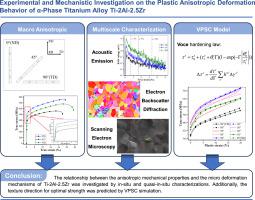当前位置:
X-MOL 学术
›
J. Mater. Sci. Technol.
›
论文详情
Our official English website, www.x-mol.net, welcomes your feedback! (Note: you will need to create a separate account there.)
Experimental and mechanistic investigation on the plastic anisotropic deformation behavior of α-phase titanium alloy Ti-2Al-2.5Zr
Journal of Materials Science & Technology ( IF 11.2 ) Pub Date : 2024-06-20 , DOI: 10.1016/j.jmst.2024.05.057 Haiyu Li , Jingtai Yu , Wenyu Jia , Qiang Lin , Jun Wu , Gang Chen
Journal of Materials Science & Technology ( IF 11.2 ) Pub Date : 2024-06-20 , DOI: 10.1016/j.jmst.2024.05.057 Haiyu Li , Jingtai Yu , Wenyu Jia , Qiang Lin , Jun Wu , Gang Chen

|
Ti-2Al-2.5Zr is widely used in piping and structural support applications, however, the rolling forming process results in anisotropic deformation during service. This behavior has implications for the manufacturing processes and structural safety assessments in engineering applications. In this study, the plastic anisotropic deformation behavior of a rolled Ti-2Al-2.5Zr plate was investigated using uniaxial tensile tests along the transverse, normal, and 45° directions. Acoustic emission, electron backscatter diffraction, and scanning electron microscopy methods were used to investigate dislocation slip and twinning mechanisms. The results indicated that different microscopic deformation mechanisms caused the significant macroscopic anisotropy of Ti-2Al-2.5Zr. The primary mechanisms involved were prismatic slip, pyramidal slip, and {10-12} extension twinning. The stress direction determined the influence of each of these mechanisms during the yielding and plastic deformation phases. Application of the visco-plastic self-consistent model established the relationship between the macroscopic mechanical responses and microscopic deformation mechanisms. It was revealed that Ti-2Al-2.5Zr achieved its optimum strength when the initial texture aligned most of the grain c-axis at angles ranging from 30° to 50° relative to the deformation direction. This finding provides a direction for the texture design of Ti-2Al-2.5Zr in engineering materials.
中文翻译:

α相钛合金Ti-2Al-2.5Zr塑性各向异性变形行为的实验及机理研究
Ti-2Al-2.5Zr广泛应用于管道和结构支撑应用,然而,滚压成型工艺会导致使用过程中产生各向异性变形。这种行为对工程应用中的制造工艺和结构安全评估具有影响。在本研究中,采用沿横向、法向和 45° 方向的单轴拉伸试验研究了轧制 Ti-2Al-2.5Zr 板的塑性各向异性变形行为。声发射、电子背散射衍射和扫描电子显微镜方法用于研究位错滑移和孪生机制。结果表明,不同的微观变形机制导致Ti-2Al-2.5Zr具有显着的宏观各向异性。涉及的主要机制是棱柱滑移、锥体滑移和{10-12}延伸孪晶。应力方向决定了屈服和塑性变形阶段中每种机制的影响。粘塑性自洽模型的应用建立了宏观力学响应与微观变形机制之间的关系。结果表明,当初始织构以相对于变形方向 30° 至 50° 的角度排列大部分晶粒 c 轴时,Ti-2Al-2.5Zr 达到最佳强度。这一发现为Ti-2Al-2.5Zr在工程材料中的织构设计提供了方向。
更新日期:2024-06-20
中文翻译:

α相钛合金Ti-2Al-2.5Zr塑性各向异性变形行为的实验及机理研究
Ti-2Al-2.5Zr广泛应用于管道和结构支撑应用,然而,滚压成型工艺会导致使用过程中产生各向异性变形。这种行为对工程应用中的制造工艺和结构安全评估具有影响。在本研究中,采用沿横向、法向和 45° 方向的单轴拉伸试验研究了轧制 Ti-2Al-2.5Zr 板的塑性各向异性变形行为。声发射、电子背散射衍射和扫描电子显微镜方法用于研究位错滑移和孪生机制。结果表明,不同的微观变形机制导致Ti-2Al-2.5Zr具有显着的宏观各向异性。涉及的主要机制是棱柱滑移、锥体滑移和{10-12}延伸孪晶。应力方向决定了屈服和塑性变形阶段中每种机制的影响。粘塑性自洽模型的应用建立了宏观力学响应与微观变形机制之间的关系。结果表明,当初始织构以相对于变形方向 30° 至 50° 的角度排列大部分晶粒 c 轴时,Ti-2Al-2.5Zr 达到最佳强度。这一发现为Ti-2Al-2.5Zr在工程材料中的织构设计提供了方向。











































 京公网安备 11010802027423号
京公网安备 11010802027423号